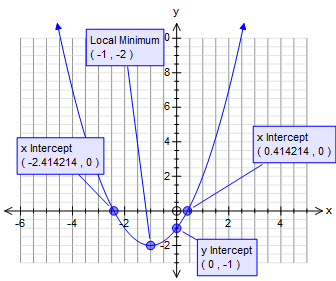Given: #y=x^2+2x-1# ....................................(1)
#color(blue)("To determine the vertex.")#
This is already in the form of #y=a(x^2+b/a x-1)# because a=1
#x_("vertex")=(-1/2)xx b/a#
This is a variation on 'Vertex Form Equation'
'::::::::::::::::::::::::::::::::::::::::::::::::::::::::::::::::::::::::::::::
In your case:
#color(blue)(x_("vertex")=(-1/2)xx(+2)=-1)#......................(2)
Substitute (2) into equation (1)
#y_("vertex")=(-1)^2+2(-1)-1#
#color(blue)(y_("vertex")=+1-2-1=-2)#
'~~~~~~~~~~~~~~~~~~~~~~~~~~~~~~
#color(blue)("To determine "y_("intercept")#
The graph crosses the y-axis when #x=0#
So #y=x^2+2x-1 -> y_("intercept")=(0)^2+2(0)-1#
#color(blue)(y_("intercept")=-1#
'~~~~~~~~~~~~~~~~~~~~~~~~~~~~~~~~~~~
#color(blue)("To determine "x_("intercepts")#
The graph crosses the x-axis when #y=0#
So # y=0=x^2+2x-1#
We need the form #y=0=(x+?)(x+?)# to find any integer factors
The only factor of 1 is 1 and to get -1 we need #(-1)xx(+1)#
which is fine until you try and get #+2x#. It fails then! So it means that the factors are not integer values. In which case we need to use the formula.
Using: #color(white)(......)y=ax^2+bx+c#
Where #color(white)(...)x=(-b+-sqrt(b^2-4ac))/(2a)#
#a=1 ; b=+2 ; c=-1#
#x=(-(+2)+-sqrt((+2)^2-4(+1)(-1)))/(2(1))#
#x=(-2+-sqrt(4+4))/2#
but #sqrt(8)=sqrt(2xx2^2)=2sqrt(2)#
#x=(-2+-2sqrt(2))/2 #
#x~~0.414" or "x~~-2.414# to 3 decimal places



